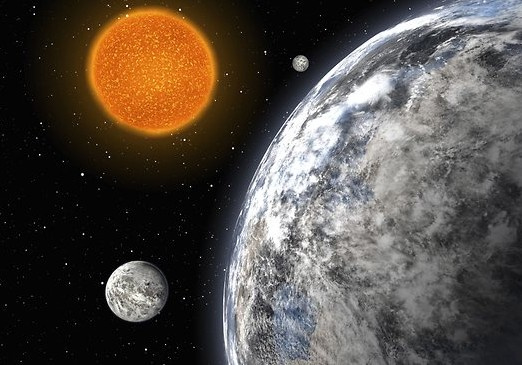Found a planet that can replace Earth?
Tau Ceti, one of our closest stars, is a potential candidate that can contain Earth-like planets. This information was published by scientists only 2 days before the time that many people considered 'Doomsday' when the Mayan counting calendar ended.
>>>There are "worth living" planets over Earth?
Astronomers on December 19 said that this star is quite close, located the way we 'only' have 12 light years. Tau Ceti is quite similar to our Sun and it has 5 planets flying around, lying on orbits that can help nourish life.
One of these planets has a mass five times the mass of Earth, making it the smallest planet found to date in the Goldilock region. The definition of Goldilock refers to the orbital distance of a planet compared to a star, where the temperature is not too hot or too cold, just enough to maintain liquid water, which is essential for life.
Since 1995 there have been 800 extrasolar planets - planets circling their stars - discovered.

The Chile telescope found 3 "Super Earths" in June 2008
But none of those planets can support life. They were either giant orbs of air that could not be lived, or a giant stone planet, so close to the star that they were almost baked red.
The Ceti Tau has been found by astronomers in Australia, England, Chile and the US thanks to a technique of filtering data collected from 6,000 astronomical observatories. Through this filtering technique, it will eliminate jamming signals, which cover the existence of planets in small quantities.
Using this technique with light emitted by Tau Ceti, it was determined that it was not the only star but a planetary system.
"This finding is in line with our recently emerging view that nearly every star has planets and galaxies must have had as many planets as Earth can afford" - Steve Vogt , an expert on hunting ex-planet planets.

European astronomers announced they had discovered
a planet with the mass of Earth, circling around the throne
Why Alpha Centari B, located about 4.3 light years away
"We are now beginning to understand that Nature seems to prefer planetary systems with orbiting planets that last less than 100 days," he announced in a press release recently obtained by the British University of Hertfordshire. recently announced - "But our solar system is not like that and no planet has orbit near the Sun than Mercury. So it can be said that our solar system is relatively bizarre and unlike most other planetary systems that Nature is born ".
On October 17, European astronomers announced they had discovered an Earth-mass planet, orbiting the star Alpha Centari B, located 4.3 light years away. shining.
However, this planet is not another "Earth" because it is not in the Goldilocks region. It runs around the star with a close range so liquid water cannot exist there.
- Discovering the planet is very similar to the earth
- The most Earth-like planet shows up
- Earth has life thanks to the planet Theia rushed in
- Your planet is closest to Earth
- What new planet is '2nd Earth'?
- Information about 'Second Earth'
- Will the sun 'devour' the Earth?
- Discovering the planet has a year of 18 hours on Earth
- 2 copies of Earth crashed into each other, shooting debris across space
- Exotic planet like most earth ever
- Discovered that 9 'super-Earths' can support life
- NASA discovered a 'super Earth' evaporating
 Van Allen's belt and evidence that the Apollo 11 mission to the Moon was myth
Van Allen's belt and evidence that the Apollo 11 mission to the Moon was myth The levels of civilization in the universe (Kardashev scale)
The levels of civilization in the universe (Kardashev scale) Today Mars, the sun and the Earth are aligned
Today Mars, the sun and the Earth are aligned The Amazon owner announced a secret plan to build a space base for thousands of people
The Amazon owner announced a secret plan to build a space base for thousands of people